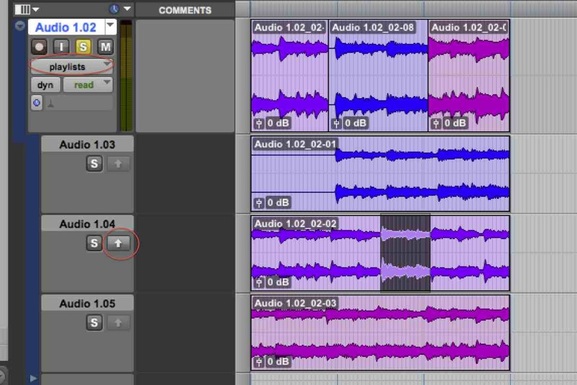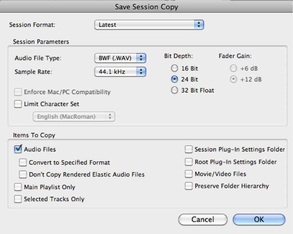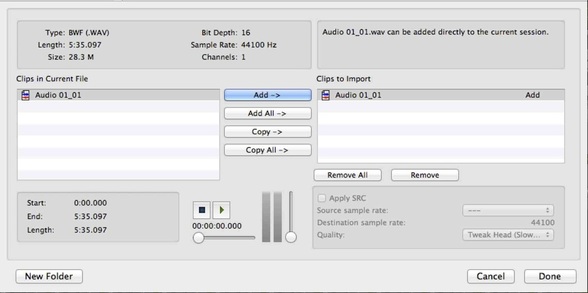Pro Tools
Comping in Pro Tools

- Preferences>Operation: Record - Automatically Create New Playlists When Loop Recording
- CONTROL-click on the Transport Record button twice, to enable Loop Record
- Set the track view to "Playlists" to see all the Takes.
- Audition with Solo, and use the Selector Tool to select the desired parts, then add them to the Comp using the Up Arrow Button.
Pro Tools Tutorials
Dr. Rik Pfenninger at the Plymouth State University has put together a series of good tutorials for Pro Tools 10. Find them here.
Daniel Booth has some good Pro Tools video tutorials on Youtube. Mostly, they cover more advanced topics.
Daniel Booth has some good Pro Tools video tutorials on Youtube. Mostly, they cover more advanced topics.
Timing Edits
Which technique to use to get parts 'in time' can be a bit confusing. Here is a handy reference chart describing the processes available in Pro Tools and Logic Audio.
| editing_timing.pdf | |
| File Size: | 139 kb |
| File Type: | |
Sample library issues
For some reason Pro Tools cannot find the sample library for Xpand2. The whereabouts of Pro Tools files is a bit haphazard. For example Plug-ins reside in Library/Application Support/Digidesign/Plug-Ins, whereas the Xpand2 samples are in Applications/Avid/Avid Virtual Instruments. The problem is that even after manually locating the .big file here, Pro Tools cannot remember it, even if another Xpand2 is inserted in the open session.
"Help, my files are missing"

Use "Save Copy in..." to include all the session assets.
A common problem I see (I'm a teacher so I see all sorts of crazy stuff) is lost Pro Tools audio files. The answer to preventing this is simple: when you start a Pro Tools project Pro Tools will create a folder to hold all the bits. Sub folders are automatically created as required for the various file types used by the project. One of these is the Audio Files folder which holds (you guessed it) the audio files. So Pro Tools does all the house keeping for the user. The only thing to watch is that if a project is moved (eg to another drive) then the project folder is moved as is, with all its included files. Trouble arises if for some reason files or folders are taken out of this project folder. In this case when the project loads it will bring up a message saying there are missing files, and give options to relink to them automatically, or manually. Neither of these methods is particularly clever, and even if the 'lost' file is placed just outside the project folder it can take several minutes for Pro Tools to locate it! Some times, it won't find them no matter how long you wait. A manual search does give the option to search only on filename. This will prevent it looking for the unique ID number that Pro Tools allocates to each file. Normally this ID would be the best way to locate a missing file. The problem is that Pro Tools is happy to issue a new ID to any lost and found file, so after a bit of filescrambling it will have no chance of finding the right ones for you. The downside of searching only on filename is that unless you rename every audio file there will be multiple files with identical names (eg audio 1_01). By now hopefully your getting the point that leaving all your Pro Tools eggs in one basket really is a good idea.
If the audio files are relocated back within the project folder Pro Tools will find them without having to resort to the search window. Another thing worth knowing is that it won't loose files put in sub folders within the folders allocated by Pro Tools.
If you need to make a copy of the session from within Pro Tools for some reason there is a helpful file command named 'Save Copy in'. The picture above shows the window and you can select which dependant files to be copied. This is different to the 'Save as' command which will just save the project file under a new name, but still link to the original locations for audio files etc.
If all else fails, you can start a new session and then import the audio files into it (providing you can actually find the files).
Fantastic though Pro Tools is, some of its features are less than intuitive, and here is an example that relates to this topic: when you import audio files the menu defaults to "add" (files to session). This will let the session use the files from the existing location, but once the session (or the audio) is moved then the link is lost. This problem can be avoided by copying files to the session so there is a separate new audio file for Pro Tools to use.
If the audio files are relocated back within the project folder Pro Tools will find them without having to resort to the search window. Another thing worth knowing is that it won't loose files put in sub folders within the folders allocated by Pro Tools.
If you need to make a copy of the session from within Pro Tools for some reason there is a helpful file command named 'Save Copy in'. The picture above shows the window and you can select which dependant files to be copied. This is different to the 'Save as' command which will just save the project file under a new name, but still link to the original locations for audio files etc.
If all else fails, you can start a new session and then import the audio files into it (providing you can actually find the files).
Fantastic though Pro Tools is, some of its features are less than intuitive, and here is an example that relates to this topic: when you import audio files the menu defaults to "add" (files to session). This will let the session use the files from the existing location, but once the session (or the audio) is moved then the link is lost. This problem can be avoided by copying files to the session so there is a separate new audio file for Pro Tools to use.
Pro Tools 10 - is the upgrade worth getting?
Find out here.
Pro Tools vs Logic Audio - automation
| logic_vs_pro_tools.pdf | |
| File Size: | 71 kb |
| File Type: | |
Pro Tools tips & tricks
- OPTION-click on 'Fit to Window' (from the track height menu of any track) to set all track heights evenly to fill the window.
- caution: auto fades can be set in the Preferences menu (and they are not generally visible).
- CONTROL-SHIFT-OPTION-3 generates a region with test tone (select an area of track first).
- To see the OUTPUT level of a buss; click on the green dot of the buss send window.
- EQ3 - sweep on boost, then SHIFT-click on the GAIN node to flip the curve to cut.
- EQ3 - CONTROL-SHIFT (then move a parameter) to solo a parameter.
- CONTROL-APPLE-OPTION-click on a meter to show wide meters.
- APPLE-click on the Shuttle Button to lock it from use.
Pro Tools 9 I/O setup changes
There are some significant changes to the I/O setup menu:
new output paths will automatically create corresponding busses
there are no longer subpaths on outputs
I/O imports only effect the current tab (e.g. outputs). Hold OPTION to import all settings
- The Playback engine window is now used to select the current engine. This can be an internal or external device.
- In Hardware setup you can now access the AMS to arrogate devices.
- There is a new I/O Setup page:
new output paths will automatically create corresponding busses
there are no longer subpaths on outputs
I/O imports only effect the current tab (e.g. outputs). Hold OPTION to import all settings
- an output can now be assigned to a track:
Going Solo
How the solo function is implemented varies slightly on mixing consoles (eg PFL, AFL, SIP), but now we have DAWs things are less obvious. Take the example of several channels bussed to an auxiliary input. Here, there are basically three modes of soloing:
A) a single channel (or combinations of channels) to monitor the dry signal,
B) the channel(s) with the FX, and
C) the FX only.
1. Physical Mixer
A. To hear a sound without FX: Solo the Channel
B. To hear a sound with its FX: Solo the Channel and the FX Return
C. To hear the FX only: Solo the FX return
2. Logic 9
A. To hear a sound without FX: Solo the Channel, and Mute the Aux
B. To hear a sound with its FX: Solo the Channel
C. To hear the FX only: Solo the Aux
Let's look at B more closely. Why can we hear the FX added to the dry signal even though we only have the solo button on the channel enabled? The answer is that this feature relies on using one of Logic’s hidden features; the ‘auto-solo-safe’ function. Solo-safe is where a signal path is not muted by another solo. In this case Logic automatically enables this to let us monitor the wet and dry signals together. The assumption is that once we assign a sound to an effect we will normally want to hear it with the effect on.
3. Pro Tools 8
This is where things get really interesting. Generally, Pro Tools follows the topology of a physical mixer more than other DAWs. This leads to certain expectations of how the software will behave. The way solo is implemented is unfortunately not intuitive, nor does it mimic signal flow in a physical mixer. The reference guide makes no mention of the unusual solo behaviour, so I have tabulated it here:
From this chart several things are apparent. Firstly, the obvious operation of soloing the Aux will not work. Why Digidesign have written the software this way is anyone’s guess. Let’s just say it is not one of their best moments. Another point is that to monitor just the wet signal the busses being sent to the Aux must be set as Pre-fade sends. Now, there is another way to Solo the wet and dry signals together; Solo-safe mode can be used (Command-click on the Solo button on the Aux – it will grey out).
So that’s all there is to it (well not quite, as I haven’t covered Groups and VCAs). I once read an interesting statement on a forum which said that the easiest way around all this is not to solo at all, as mixing is about…well, mixing.
So that’s all there is to it (well not quite, as I haven’t covered Groups and VCAs). I once read an interesting statement on a forum which said that the easiest way around all this is not to solo at all, as mixing is about…well, mixing.
What's wrong with Pro Tools LE
Pro Tools is generally accepted as being the total solution for all music / post production (according to Avid, anyway). But lately I have been hearing more negatives about it. So to balance things a little I thought I would share the dark side of this fantastic software:
These comments refer to using Pro Tools LE on a Mac running OS X, and relate to using the programme for 1000s of hours across all Mac hardware and all versions of OS.
1. It is always buggy. Some software just goes (OS upgrade after OS upgrade); eg Logic, MS Office. Not Pro Tools.
2. It is never qualified for the latest release of OS. This means that bugs fixed in other programmes cannot be resolved or the new OS version will likely as not break Pro Tools.
3. New features are slow to arrive. Remember the wait for multiple undos? Look at what was offered in the latest version (8): some softsynths, a better reverb plugin, and a separate MIDI edit window. Five years ago I would have been impressed. Now they are just playing catch up.
4. Following on from point 4, the quality of the new additions is poor. The long awaited Air reverb sounds grainy / metallic / harsh.
The piano plugin sound can only be called usable, and is not a breakthrough by any means. Also the number of items included in the plugin / softsynth bag is stingy when compared to Logic.
5. Attributing to the finickityness of Pro Tools is the fact that it ignores the very stable and low latency Core Audio to use Digidesigns DAE. While this made sense in OS9 it has become the Archillles heel when running it on OS X.
6. Pro Tools only runs on its own hardware. This locks the user in to the Digidesign way. Other audio software will let you choose.
7. Pro Tools has its own plugin format (RTAS). Because it is a proprietary design very few freeware / shareware developers support it (unlike VST, AU). Digidesign plugin partners therefore make good but very expensive FX and Virtual Instruments.
8. The MBox 2 Micro is a complete ripoff. Why should I pay again for software I have already bought.
9. The new Avid search engine (which you'll need - refer to point 1) does't always find things. At least with the old site I was able to manually search for articles.
10. What should I do with my MBox now that will not work with the latest software upgrade? Pro Tools 8.0.3 is required to run on Snow Leopard but no longer supports the MBox. Luckily, the solution has already been thought of by the Digidesign marketing dept - buy a new MBox2.


